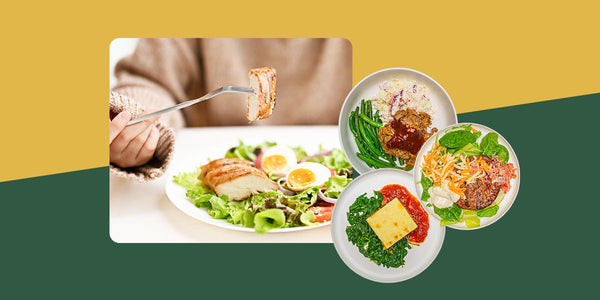Grocery shopping and preparing meals can be time-consuming and frustrating, particularly when trying to improve your diet. For example, incorporating more fruits and vegetables often prompts the debate about whether to buy and use fresh or frozen ingredients. Many of us intuitively know that fresh is best, but what about fresh vs. frozen?
That question may run through your mind as you make your way through the produce section. While fresh and frozen foods have their pros and cons, you can certainly get the best of both worlds. We’re here to put the misinformation to rest and dive deep into the debate between fresh versus frozen meals.
What Counts as Fresh Food?
The definition of fresh food varies. For some, fresh food is anything that doesn’t require constant refrigeration. For others, fresh food has to be straight from the source. Fresh food usually refers to any fruit, vegetable or meat product that isn’t overly processed or preserved, including salting, drying, smoking, dehydrating, canning, pickling or freezing to prevent spoiling.
Fresh Food Examples
For example, fresh fruit or vegetables are recently harvested and fresh meat is recently butchered or caught and kept cold for consumers. Farmers pick most fruits and vegetables you see in the produce section well before they’re ripe. An early harvest allows them to remain fresh for consumers as they ripen and develop their natural vitamins and minerals during transportation. Once they reach the grocery store, most fresh fruits and vegetables remain on display for about three days.
The term fresh implies newness — that the food is at its very best and hasn’t been sitting on a shelf for months or years at a time. However, depending on where you shop, your store may use approved waxes, coatings or pesticides to protect the fresh produce.
What Counts as Frozen Food?
Frozen food is any type of food that the processor has frozen and preserved, typically for sale in the frozen state. Processors freeze food to slow the decomposition of fresh food and prevent bacterial growth. This food can stay on shelves for months or years, while fresh food typically only lasts a few days. Frozen food is convenient for many consumers with busy schedules or large families who may not always have time to prepare and cook fresh food.
Farmers typically pick frozen fruits and vegetables during peak ripeness to preserve their nutritional value. Once harvesting is complete, they usually wash, cut, freeze and package the produce within a few hours. Most commercial businesses can speed up this process by using flash freezing. By exposing food to extremely low temperatures, they can freeze it quickly and prevent ice crystals from forming.
Since freezing is a natural form of preservation, frozen foods might not contain additional preservatives. However, many contain added sugar, sodium, ascorbic acid or additives like butylated hydroxyanisole (BHA) to prolong their shelf life.
How Is Fresh Food Handled?

Locally-sourced items at your grocery store are the best way to incorporate high-quality, longer-lasting fresh meat and produce. Let’s take a look at how food production sources, handles and stores fresh foods.
Sourcing
Grocery stores procure fresh and frozen vegetables, fruits, meats and other foods from several sources, most often through distributors, local farms or importers. Most grocery stores rely on several distributors to keep the shelves filled with fresh food. Some distributors specialize in specific grocery items, while larger retailers may specialize in produce or meats.
While you may have several local farms, they typically don’t produce enough to fill an entire grocery store, particularly when items are out of season. Some foods, like potatoes and carrots, are in season all year round, but others prefer the summer heat. In this case, grocery stores often work with distributors across state lines. However, this doesn’t mean that the produce or meat isn’t fresh. Farmers decide which items to distribute and play a critical role in ensuring proper handling.
Many consumers prefer locally sourced food. This term is often associated with freshness since fresh food can’t travel too far without some type of preservation. Consumers can trust that spending less time in transit has preserved the nutritional value of fresh food.
Handling and Storage

Once fresh produce and meats are ready to head to grocery stores, producers properly clean and package them for their destination. Grocery items are carefully handled and transported in temperature-controlled storage units before making their way to your local grocery store. The meat, fish and produce arrive at the destination without using preservatives or added ingredients to keep the food fresh.
Farmers often harvest produce before it’s fully ripe to account for travel time. You may even notice that some fresh vegetables and fruits, like avocados or peaches, can take up to a week to fully ripen once you take them home.
Meats and fish, including beef, chicken and salmon, have slightly different handling and storage needs compared to fruits and vegetables. For example, grass-fed animals and wild-caught fish often have higher handling standards than commercial cattle. This fresh meat and fish is appropriately cleaned, tested for freshness and bacteria and packaged for refrigerated transportation.
How Is Frozen Food Handled?
Frozen foods typically don’t have to meet the same standards for freshness or time-sensitive transportation. This difference means grocery stores and food distributors can source their produce and meats from longer distances if needed. Let’s see how frozen food sourcing, handling and storage differs from fresh food.
Sourcing
Fresh and frozen fruits, vegetables, meat, fish and other foods are generally sourced the same way. Grocery stores will partner with distributors, farmers and retailers to keep their aisles stocked for consumers. However, since frozen food is often preserved with additional sugar, sodium or other additives, grocery stores have more food-sourcing options.
While stores usually need to purchase fresh produce from a reasonably close location, they can buy frozen food items from across the country if needed.
Handling and Storage
Frozen food must remain at a consistent freezing temperature to prevent bacteria from breeding and causing food-borne illnesses. Distributors must ensure that all frozen foods are kept at a safe temperature throughout transit. Even a slight temperature fluctuation can lead to freezer burn, which changes the texture and flavor of the food. Additionally, frozen and refrigerated food cannot be placed together, as it can impact the food quality and product integrity.
Some items, like meat, may be frozen to preserve their freshness during transportation across long distances. When meat is only frozen for transport, grocery stores often defrost it and sell it as fresh. Some consumers prefer to look for labels that say “fresh, never frozen” to ensure true freshness.
Frozen vegetables, on the other hand, undergo blanching before they’re frozen. Blanching is the process of briefly scalding the vegetables in boiling water or steam before plunging them into ice water. This process helps lock in the vegetables’ color, flavor and nutrients. Since frozen fruit is typically served raw, it usually doesn’t undergo a blanching process.
Producers can freeze in a number of ways. As mentioned above, many use the flash freeze method. Others may use the air-blast method — where the food enters a narrow tunnel with ultra-cooled air — or use metal plates and refrigerated liquid. Once frozen, these items remain in storage units until delivered at the grocery store.
Key Differences Between Fresh and Frozen Food
It’s clear that fresh and frozen foods have differences in their preservation and freshness, but what about their nutritional value and price? Are there other aspects that set them apart? Let’s see how fresh and frozen foods really differ.
Essential Vitamins and Nutrients
Fresh food generally supplies more nutrients, hydration, enzymes and healthful fats. If that’s the case, does frozen food lose nutrients? Though freezing foods doesn’t drastically reduce a meal’s nutrient value, it may slightly decrease specific vitamins and minerals, such as vitamin C.
A prepackaged frozen meal usually provides small quantities of fruits and vegetables, often containing added sugar and sodium for preservation. In this case, the amount of salt and sugar you’re absorbing may be more than the actual nutritional value of frozen food. On the other hand, when you prepare fresh produce you can control the amount of salt, oils and healthful fats you add to them.
Freezing foods also tends to lower enzyme activity for preservation. However, those enzymes are essential for digestion and liver function, helping you break down and absorb food. In fact, not having enough of a certain enzyme can affect your gut health and even lead to certain conditions like Crohn’s disease.
Shelf Life
The shelf life of your food depends on many different factors, including the type of food, the temperature of your fridge or freezer and how you store your fresh food. Because most fresh food usually contains minimal preservatives, the natural lifecycle of fruits, vegetables and meat can be much shorter than frozen food:
How long does frozen food last?
Almost all frozen food can last at least one to two months in proper storage. According to U.S. guidelines, some poultry and shellfish can even last up to a year or more in freezing temperatures. However, improperly storing frozen food can give it essentially the same shelf life as fresh food. For example, opening a bag of frozen fruit and not closing it properly can lead to excess air leaking into the bag and causing freezer burn.
How long does fresh food last?
Fresh food can last anywhere from days to weeks in refrigeration or room temperatures. Refrigerated blueberries can last for one to two weeks, while broccoli and cauliflower stay fresh for up to five days. Meanwhile, you should use fresh steak, seafood and chicken within a few days of refrigeration.
Quality

Recently, more and more consumers are turning to fresh food for quality. While frozen food is certainly safe and healthy to eat, it may not provide the same excellence as fresh, locally-sourced food.
Since many fruits and vegetables, for example, are made up of 90% water, freezing these items expands the cell walls of the produce. When the items are thawed, it leaves the produce much softer and mushier than fresh produce. This watery texture can often be less appetizing.
According to a study, 71% of respondents prefer fresh food for quality and safety purposes and 78% reported they would pay more for fresh food. Additionally, 64% of consumers in the same study reported interest in subscription services, likely to avoid food waste and reap the convenient benefits of freshly prepared food.
Is Fresh Food More Expensive Than Frozen Food?
As with all items, both fresh and frozen foods fluctuate in price depending on where you live, the season and where you shop. Generally, frozen food tends to be slightly cheaper than fresh food because it doesn’t need to be transported and delivered within a short time frame. However, in some cases, the cost of freezing, processing and storing frozen foods can add to the price you see at the store.
Since frozen foods can be stored longer than fresh foods, they often save consumers a bit of money. However, you might find that certain grocery store items are much more expensive frozen than fresh. A report found that frozen grocery store meat went up in price by 28% last year, whereas fresh meat only increased by 5%,
Which Should You Pick?
The type of groceries you buy depends on your dietary needs and preferences. You may be willing to pay a few extra cents for locally sourced items or only choose grass-fed and hormone-free meats. Frozen foods, on the other hand, are convenient to have on hand if you’re out of fresh produce or you need to make a quick meal after a long day.
Ultimately, it depends on the type of items you buy, how you store them and how much food you unintentionally waste at home. If you’re trying to improve your diet and incorporate more healthy, natural ingredients, then fresh is the way to go. To prevent fresh produce from going to waste, consider a meal delivery plan service that provides balanced, full-cooked, never-frozen meals.
Fresh Meal Plan — Fresh, Never Frozen, Just as Convenient
If you’re looking for an easier way to incorporate fresh ingredients without all the preparation and cooking, consider ordering meals from Fresh Meal Plan. Our meal subscription plan delivers fresh, locally sourced ingredients to your door so you always have a healthy meal in the fridge.
Professional chefs prepare our meals each day with no artificial ingredients or preservatives, meaning you get freshly crafted meals right to your table. We offer hundreds of menu items that meet a wide range of dietary needs and preferences, including vegan, gluten-free — not prepared in a gluten-free kitchen — and keto meals. You can prepare each of our meals in three minutes or less. If you’re looking to improve your diet and eliminate time in the grocery store, get started with a Fresh Meal Plan today.






